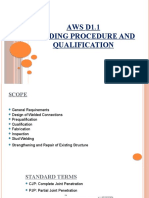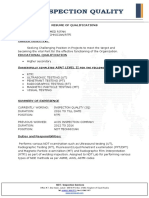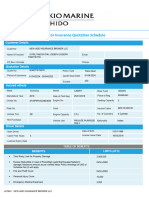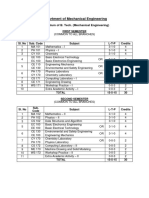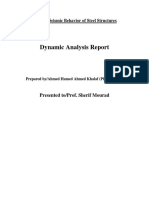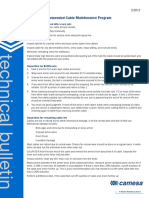0 ratings0% found this document useful (0 votes)
265 viewsQuestionnaires For Welding Engineer
Questionnaires For Welding Engineer
Uploaded by
Cyril J PadiyathThis document contains a list of 100+ questions related to welding engineering, welding processes, welding equipment, welding defects, welding positions, welding variables, materials, drawings, and safety. The questions cover topics such as dangerous things to control during welding, filler wires vs electrodes, welding machine types, arc characteristics, joint preparation, weld defects, welding symbols, welder classification, procedures, heat treatment, shielding gases, filler material specifications, essential and non-essential variables, distortion control, radiation hazards, and more. It also includes a smaller set of questions for fitters related to reading drawings, measurements, joint fit-up, material handling, scaffolding, and field erection activities.
Copyright:
© All Rights Reserved
Available Formats
Download as DOC, PDF, TXT or read online from Scribd
Questionnaires For Welding Engineer
Questionnaires For Welding Engineer
Uploaded by
Cyril J Padiyath0 ratings0% found this document useful (0 votes)
265 views7 pagesThis document contains a list of 100+ questions related to welding engineering, welding processes, welding equipment, welding defects, welding positions, welding variables, materials, drawings, and safety. The questions cover topics such as dangerous things to control during welding, filler wires vs electrodes, welding machine types, arc characteristics, joint preparation, weld defects, welding symbols, welder classification, procedures, heat treatment, shielding gases, filler material specifications, essential and non-essential variables, distortion control, radiation hazards, and more. It also includes a smaller set of questions for fitters related to reading drawings, measurements, joint fit-up, material handling, scaffolding, and field erection activities.
Original Description:
welding engineer
Original Title
Questionnaires for Welding Engineer
Copyright
© © All Rights Reserved
Available Formats
DOC, PDF, TXT or read online from Scribd
Share this document
Did you find this document useful?
Is this content inappropriate?
This document contains a list of 100+ questions related to welding engineering, welding processes, welding equipment, welding defects, welding positions, welding variables, materials, drawings, and safety. The questions cover topics such as dangerous things to control during welding, filler wires vs electrodes, welding machine types, arc characteristics, joint preparation, weld defects, welding symbols, welder classification, procedures, heat treatment, shielding gases, filler material specifications, essential and non-essential variables, distortion control, radiation hazards, and more. It also includes a smaller set of questions for fitters related to reading drawings, measurements, joint fit-up, material handling, scaffolding, and field erection activities.
Copyright:
© All Rights Reserved
Available Formats
Download as DOC, PDF, TXT or read online from Scribd
Download as doc, pdf, or txt
0 ratings0% found this document useful (0 votes)
265 views7 pagesQuestionnaires For Welding Engineer
Questionnaires For Welding Engineer
Uploaded by
Cyril J PadiyathThis document contains a list of 100+ questions related to welding engineering, welding processes, welding equipment, welding defects, welding positions, welding variables, materials, drawings, and safety. The questions cover topics such as dangerous things to control during welding, filler wires vs electrodes, welding machine types, arc characteristics, joint preparation, weld defects, welding symbols, welder classification, procedures, heat treatment, shielding gases, filler material specifications, essential and non-essential variables, distortion control, radiation hazards, and more. It also includes a smaller set of questions for fitters related to reading drawings, measurements, joint fit-up, material handling, scaffolding, and field erection activities.
Copyright:
© All Rights Reserved
Available Formats
Download as DOC, PDF, TXT or read online from Scribd
Download as doc, pdf, or txt
You are on page 1of 7
QUESTIONNAIRES FOR WELDING ENGINEER / SUPERVISOR &WELDERS
1. What are the main 3 dangerous things to be controlled during welding?
2. What is the difference between the filler wire and arc electrode?
3. When and what purpose filler wire is used?
4. What is the polarity during GTAW & SMAW welding?
5. What is the difference between the GTAW and SMAW welding?
6. What are the welding machines are normally used for welding?
7. What is arc and arc length?
8. What is the difference between welding generator and transformer?
9. What is the root gap for GTAW & SMAW?
10. What is low hydrogen electrodes and basic coated electrodes?
11. What is backing and what are the electrodes are to be backed?
12. What are the checks to be carried out during electrodes receipt at stores?
13. Why AC current is not used with welding generator?
14. Which machine gives the required polarity?
15. What is the difference between the GTAW torches and SMAW electrode holder?
16. What is the material used for welding & cutting nozzles?
17. What is the color for the following cylinders
a) Organ b) oxygen C) acetylene d) nitrogen
18. What is the difference between the organ regulator and gas-cutting regulator?
19. What is the function of the gauges fitted on the above regulator?
20. What are the different flames set on the gas cutting torches?
21. What are the different glasses used for the welding goggles & gas cutting goggles?
22. What are all the different types of welding?
23. What are all the different types of weld joints?
24. What are all the different types of weld defects?
25. What are all to be checked during pipe joint fit-up?
26. What is welding symbol?
27. How a welder can be classified?
28. What is WPS and PQR ?
29. What is welding job card?
30. What is pree heat and post weld heat treatment?
31. What is shielding and baking?
32. What gas is to be used for purging?
33. What is the purpose of portable oven?
34. Electrical lose connections gives what hazards?
35. What is the electrodes baking temperature and baking duration?
36. What is P number for CS, AS &SS materials?
37. What is AWS number for the electrodes used for CS,AS &SS materials welding?
38. What is AWS number for the filler wires used for CS,AS &SS materials welding?
39. What is the current and voltage requirement for SMAW (dia-2.5, 3.15,4.0mm)?
40. What is the current and voltage requirement for GTAW?
41. What are the different types of welding groves?
42. Where single and double groves are used?
43. Define ark blow, burn through ,cavity, undercut &gas hole
44. Define Lack of Penetration, Lack of Fusion &Excess Penetration
45. Define tungsten inclusion ,slag inclusion &porosity
46. What are the different welding positions on pipes and plates?
47. What are the essential variables?
48. What are the non- essential variables?
49. What are the supplementary essential variables?
50. Define reinforcement.
51. What is back fire ?
52. How to prevent back fire ?
53. What is the purpose of metal cap for gas cylinder/
54. Explain oxidation, reduction &carbonizing flame.
55. what is the difference between welding torch and cutting torch?
56. What is inter pas temperature and why it is to be maintained?
57. What non consumable used in GTAW?
58. What is tungsten rod angle during welding?
59. What is the advantage of GTAW welding?
60. What is distortion and how to control it ?
61. What is arc strike?
62. How to handle SS materials?
63. What are the additional care to be taken during SS welding?
64. SS materials are not permitted to mix up with other materials why?
65. What are the different types of grinding machines?
66. What are the protective welder should use during welding ?
67. What are the pree-cleaning activities to be completed before fit-up?
68. What NDT to be used for root check?
69. During visual inspection on root weld and final weld, what are all to be looked for?
70. Why weld spatters occurs?
71. What is GA drawing?
72. What is isometric drawing?
73. what is flow sheet?
74. What is fabrication drawing?
75. What is pipe?
76. What is tube?
77. What is tolerance?
78. What is unit for current and voltage?
79. What instrument normally used for measuring current and voltage?
80. What is current loss?
81. What is open circuit voltage and ARC voltage?
82. What are the harm rays produced during welding?
83. How current control is possible on AC &DC welding machine?
84. What is up-hill and down hill ?
85. What is miss-match?
86. What is mean by slope on the pipe line?
87. What precaution to be taken during welding of valves?
88. How to measure the size of fillet welds?
89. What is the purpose of ultrasonic thickness measuring gauge?
90. What is DT and NDT ?
91. What is tensile strength?
92. What are all the different NDT used in welding field?
93. Define the term stress and strain ?
94. How carbon steel is classified?
95. How alloy steel is classified?
96. Define stress reliving and why it is required?
97. Why welding is specified as special process?
98. How weld joints are identified?
99. What is mean by a good welder?
100.Explain the function of coating of electrodes?
101.Explain the meaning of low hydrogen of electrodes?
102.What are the different mode of heat transfer?
103.What are the different accessories used for GTAW?
104. What are the different accessories used for SMAW?
105. What is the role of welding helper?
106.What is first angle and third angle projection?
107.Which ASME section deals about welding and bracing qualification?
108.ASME section VIII deals about what?
109.How you will calculate welder performance?
110. What do you mean by a sound weld?
111.What is a defect?
QUESTIONNAIRES FOR FITTERS
1. How to read the drawing?
2. What is the isometric drawing?
3. What is GA drawing?
4. What is DD drawing?
5. What is flow sheet?
6. What is fabrication drawing?
7. What is first angle projection?
8. What is third angle projection?
9. What is slope?
10. How slope is marked on the drawing?
11. How hangers are marked on the drawing?
12. What is weld joint fit-up?
13. How you will do a joint fit-up?
14. What is root gap?
15. What is mismatch?
16. What is over lap?
17. What is ovality?
18. How you will measure an edge preparation as per drawing?
19. How to measure root gap?
20. What is least count?
21. What is calibration?
22. What is least count of measuring tap?
23. Where you will use venire caliper and micrometer?
24. What is in side micrometer?
25. What is out side micrometer?
26. Where you will use dial gauge?
27. How to set a dial gauge?
28. How much mismatch permitted for GTAW welding?
29. What is land?
30. How much land should be maintained for manual welding?
31. What is arresting?
32. What is distortion?
33. How you will prepare a V groove?
34. How you will prepare a J groove?
35. What is blue matching?
36. Where blue matching required?
37. What is the purpose of file?
38. What are the various files you have used?
39. What is square ness?
40. What are all the instruments used for leveling?
41. How to check the correct ness of the sprit level?
42. Where you will use water level?
43. What is the accuracy of water level?
44. How you will remove air in the water level tube?
45. How to check there is no air in the water level tube?
46. Where to take the measurement in the water level (bottom or top)?
47. During fit-up what are all the points to be checked?
48. How materials are identified?
49. How materials are stacked?
50. What is handling procedure?
51. What is erection procedure?
52. How you will erect a permanent support?
53. Where you will weld a temporary support?
54. What are the safety precautions to be taken when you are working at very high level?
55. What is the purpose of safety belt?
56. What is scaffolding arrangement?
57. How to identify vertical and horizontal rolling in drawing?
58. What is the inclined position of the isometric drawing?
59. How to identify the direction in the drawing?
60. Before starting piping erection at site, what are all the clearances to be obtained?
61. How to identify the joint whether that is shop joint or field joint?
62. What are all the in formations taken from the drawing?
63. Revision R1, R2,R3 of the same Drawings are given to you. Which drawing you will use for job?
64. Vertical hatch lines and horizontal hatch lines on the drawing indicates what?
65. What is tolerance?
66. What is weld symbol?
67. What do you mean by fittings?
68. How to erect a valve?
69. What are all the different types of hangers?
70. How you will identify the flow direction?
71. How valves are erected on the flow direction?
72. What is NRV?
73. How flanges are identified on the drawing?
74. How you will erect the flanges?
75. What is gas-cut?
76. What is torque value?
77. What is dame? And what for it is used?
78. How a weld joint number is identified?
79. Where weld joint number is to be punched?
80. What is line number?
81. How you will preserve the fit-up?
82. What are the various way to avoid fouling of lines?
83. What is house keeping?
84. What are all the fire safety measures to be taken during erection?
85. Drain points are to be fixed at what location?
86. Vent points are to be fixed at what location?
87. What is shipping list?
88. What is DU ,NO ?
89. How direction is found on the drawing?
90. Bill of materials is given for what?
91. What is the purpose of rectangular try square?
92. How sings are put on valves for lifting purpose?
93. How cleats are placed over the pipe during fit-up?
94. How you will fix the dams?
Dos
1.
2.
3.
4.
5.
6.
7.
8.
Us the latest revision of drawings for the job.
Confirm the revision of the drawing before starting the fabrication.
Understand the requirement of piping material as per drawing fabrication.
Check for completeness of all the required information in the drawing.
Check for correctness of Bill of Material with reference to spool quantity.
Deviations from the drawings should be taken only after concurrence of the engineer is taken.
Preserve and store drawings after use.
Return the old revision immediately on received of the latest one.
Dont
1.
2.
3.
4.
5.
Dont use the old revision for fabrication.
Dont deviate from the drawings without written approval.
Dont mistake between shop & field joint.
Dont scatter the drawings in shop and at field.
Dont assume any thing, if not explicitly given the drawing.
QUESTIONNAIRES FOR RIGGERS
1. What are slings?
2. What is wire rope?
3. What is rope?
4. What is safe angle?
5. What is safe load?
6. How to lift a material from one place to other place?
7. What are all the in formations required before lifting a pipe?
8. Shall we directly wind the sling on the pipe?
9. How you will communicate the information to the operator?
10. What are all the different signals being followed among rigging group?
11. What are all the safety points to be followed during the lifting of pipe material?
12. What are all the safety points to be followed during the lowering of pipe material?
13. What for the hand gloves?
14. What for different size (dia) of ropes/slings are required?
15. What for different size (dia) of ropes/slings are required?
16. What for different length of ropes/slings is required?
17. Who will instruct you to do job?
18. What you mean by house keeping?
19. What are all the safety practices are to be followed at your job?
20. What is the requirement of lighting arrangement for rigging job?
21. How you will maintain the slings/ropes?
22. Why grease or oil is applied over rope/slings?
23. How you will check the healthiness of rope/slings?
24. Where you will keep the damaged slings?
25. What is contact angle?
26. An eye check-up is required for rigger?
27. Why whistle is required?
28. What Extra care should be taken during valve lifting?
29. What Extra care should be taken during equipment (machine) lifting?
30. For fire protection what are all to be done?
31. Why signal failures are happening?
32. What is mean by slippage?
33. Why wooden blanks are provided between job and ropes during lifting?
34. How materials are balanced during lifting?
35. What is the responsibility of a rigger?
36. Any document is required for rigging job?
37. Why job knowledge is required for rigger?
38. Who will lead the rigger team?
39. Method of lifting and movement is to be preplanned
40. In emergency how you will act to save material and machine?
You might also like
- KPPSC SDO Test QuestionsDocument3 pagesKPPSC SDO Test Questionssalman khattak67% (3)
- Common Defects in Gas CuttingDocument14 pagesCommon Defects in Gas CuttingASHVIN YADAVNo ratings yet
- Pressure Gauge For Manifold 028200231: LegendDocument1 pagePressure Gauge For Manifold 028200231: LegendMuhammad HassanNo ratings yet
- AWS CWI SyllabusDocument1 pageAWS CWI SyllabusMayank GuptaNo ratings yet
- Resume SampleDocument4 pagesResume SampleGokulPrasadNo ratings yet
- Follow HereDocument18 pagesFollow HereAkram Alhaddad100% (1)
- SULB Product Catalogue PDFDocument46 pagesSULB Product Catalogue PDFCyril J PadiyathNo ratings yet
- Gas Laws (Notes) PDFDocument9 pagesGas Laws (Notes) PDFHassan Jamal100% (1)
- 2008 Mech PDFDocument82 pages2008 Mech PDFmotuandgoluNo ratings yet
- 10.75 BC CSGDocument1 page10.75 BC CSGharyantoNo ratings yet
- Saw Weld ProcedureDocument21 pagesSaw Weld ProcedurePhani KumarNo ratings yet
- Cswip3.2 Content ONLYDocument3 pagesCswip3.2 Content ONLYSathishkumar. KNo ratings yet
- Cswip Section 13 Mig Mag WeldingDocument23 pagesCswip Section 13 Mig Mag WeldingNsidibe Michael EtimNo ratings yet
- Gmaw and Metal TransferDocument14 pagesGmaw and Metal TransferAnant AjithkumarNo ratings yet
- SmawDocument78 pagesSmawBrijraj PandeyNo ratings yet
- GMAWDocument53 pagesGMAWJithuJohn100% (2)
- MCQ (Awt) Unit-3Document6 pagesMCQ (Awt) Unit-3So nuNo ratings yet
- Top 6 Hydrogen Cracking - Cswip 3.1 Course Questions and AnswersDocument3 pagesTop 6 Hydrogen Cracking - Cswip 3.1 Course Questions and AnswersJlkKumarNo ratings yet
- Types of ElectrodesDocument8 pagesTypes of ElectrodesTIBEBUNo ratings yet
- Heat Input Effects in WeldingDocument34 pagesHeat Input Effects in WeldingMohammed SulemanNo ratings yet
- General Mock ExamDocument7 pagesGeneral Mock ExamkennyNo ratings yet
- Interview QuestionDocument5 pagesInterview Questionsayed qutboddinNo ratings yet
- Optimization of Submerged Arc WeldingDocument4 pagesOptimization of Submerged Arc WeldingricardoNo ratings yet
- CSWIP Question AnswersDocument11 pagesCSWIP Question AnswersMuhammed Sulfeek100% (1)
- Candidate's Name: - Nationality/Location: - Interview Date: - Interviewer(s)Document4 pagesCandidate's Name: - Nationality/Location: - Interview Date: - Interviewer(s)Ahmed Hassan100% (1)
- Miller - Joint Design and Weld TypeDocument8 pagesMiller - Joint Design and Weld Typed_beachboyzNo ratings yet
- QC Weld PDFDocument13 pagesQC Weld PDFSATHAM HUSSAINNo ratings yet
- AWS D1.1 Welding Procedure and QualificationDocument26 pagesAWS D1.1 Welding Procedure and Qualificationhggdh ndbbdNo ratings yet
- Sarizal Sirim Physic - CWE - Certified Welding Engineer ExamDocument39 pagesSarizal Sirim Physic - CWE - Certified Welding Engineer Examsarizal100% (1)
- UTP MaintenanceDocument28 pagesUTP MaintenanceAnonymous PkAjjOZBNo ratings yet
- Question & Answer IDocument36 pagesQuestion & Answer IvenkateshNo ratings yet
- Welding Qualification1Document57 pagesWelding Qualification1balu100% (1)
- Question 8Document31 pagesQuestion 8Ehsan KhanNo ratings yet
- Template CV Sat Diver Ver 2Document5 pagesTemplate CV Sat Diver Ver 2subsea7divingcvNo ratings yet
- Welding InspectorDocument21 pagesWelding InspectorHamid MansouriNo ratings yet
- Muhammed Rifan RTFIDocument2 pagesMuhammed Rifan RTFIriffdNo ratings yet
- 2-Cswisp Slides Jan 2014.review PDFDocument555 pages2-Cswisp Slides Jan 2014.review PDFيوسف عادل حسانينNo ratings yet
- Question Paper For Snr. WeldingDocument3 pagesQuestion Paper For Snr. WeldingThulasi Ram100% (1)
- Ceramic Weld Backing EvaluationDocument106 pagesCeramic Weld Backing EvaluationcanakyuzNo ratings yet
- WPS & PQR & WPQDocument26 pagesWPS & PQR & WPQrakanalammari505No ratings yet
- Submerged Arc Welding: by L D PoyyaraDocument35 pagesSubmerged Arc Welding: by L D Poyyaraanon_293243615No ratings yet
- A Review Paper On Effect of Input Welding Process Parameters On Structures and Properties of Weld in Submerged Arc Welding ProcessDocument5 pagesA Review Paper On Effect of Input Welding Process Parameters On Structures and Properties of Weld in Submerged Arc Welding ProcessZarif YusufNo ratings yet
- Welding Joint Design & Welding Symbols - Chapter #5Document21 pagesWelding Joint Design & Welding Symbols - Chapter #5JACKMAAAANo ratings yet
- A Brief Synopsis ofDocument54 pagesA Brief Synopsis ofpatel ketan100% (2)
- En 1418 Approval Testing For Welding Operators For Fusion Welding For Automatic WeldingDocument12 pagesEn 1418 Approval Testing For Welding Operators For Fusion Welding For Automatic WeldingPreejith JNo ratings yet
- 400 Q PDFDocument91 pages400 Q PDFAhmed FoudaNo ratings yet
- Model - 5Document26 pagesModel - 5PrabuNo ratings yet
- CSWIP 3.1 Course Note 2016 With Question & AnswersDocument3 pagesCSWIP 3.1 Course Note 2016 With Question & AnswersSakthi Pk100% (1)
- Asme Sec 9Document12 pagesAsme Sec 9ckkashyap0007100% (1)
- Api - 1104 - 1Document2 pagesApi - 1104 - 1aditya bhideNo ratings yet
- CSWIP Questions NewDocument80 pagesCSWIP Questions NewHossam EssawyNo ratings yet
- Question ShopDocument112 pagesQuestion ShopThân Kha100% (3)
- Interview QuestionsDocument5 pagesInterview Questionsavinash1987100% (1)
- Day 1 QuestionsDocument31 pagesDay 1 Questionshaoues23No ratings yet
- Welding Process and TechnologyDocument63 pagesWelding Process and TechnologySuresh KumarNo ratings yet
- CH5 - Geometry - TeminologyDocument24 pagesCH5 - Geometry - TeminologyEdgar SerafinNo ratings yet
- 6-Laser Beam Welding MFTDocument11 pages6-Laser Beam Welding MFTRamu AmaraNo ratings yet
- Variables WeldingDocument18 pagesVariables WeldingJJNo ratings yet
- 1 - CBT Welding NDT 26 02 2020 - Ans and ExplanetionDocument27 pages1 - CBT Welding NDT 26 02 2020 - Ans and ExplanetionAMALENDU PAUL100% (1)
- Qa QC QuesationsDocument9 pagesQa QC Quesationsniminkp123100% (10)
- Practice Questionnaire For New Omani QAQC Staff - DLQ DeptDocument7 pagesPractice Questionnaire For New Omani QAQC Staff - DLQ DeptSuliman Al RuheiliNo ratings yet
- Actual Questions Asked in BARC Interview Metal Cutting and Machine ToolDocument11 pagesActual Questions Asked in BARC Interview Metal Cutting and Machine Toolgabow21252No ratings yet
- Questions: ST RD RDDocument4 pagesQuestions: ST RD RDjohnnyNo ratings yet
- Interview Basics Questions 1Document2 pagesInterview Basics Questions 1analsee202003No ratings yet
- Biw Interview QusDocument3 pagesBiw Interview QusSujay AvatiNo ratings yet
- Tool and Die QuestionsDocument8 pagesTool and Die QuestionsKishan SahuNo ratings yet
- Scad 2012 3 3 228Document6 pagesScad 2012 3 3 228Cyril J PadiyathNo ratings yet
- Tokio QuoteDocument5 pagesTokio QuoteCyril J PadiyathNo ratings yet
- Cancellation of Work Permits and Employment ContractsDocument3 pagesCancellation of Work Permits and Employment ContractsCyril J PadiyathNo ratings yet
- Polymers 14 02830 v2Document47 pagesPolymers 14 02830 v2Cyril J PadiyathNo ratings yet
- Calibration Certificate 1Document1 pageCalibration Certificate 1Cyril J PadiyathNo ratings yet
- Ticket Mahzooz Friday-1Document1 pageTicket Mahzooz Friday-1Cyril J PadiyathNo ratings yet
- Comments Resolution Sheet (CRS)Document27 pagesComments Resolution Sheet (CRS)Cyril J PadiyathNo ratings yet
- Stylish Teaching Cover LetterDocument1 pageStylish Teaching Cover LetterCyril J PadiyathNo ratings yet
- FANR - RG007 Ver1Document64 pagesFANR - RG007 Ver1Cyril J PadiyathNo ratings yet
- 20MM EsarDocument1 page20MM EsarCyril J PadiyathNo ratings yet
- FANR-RG-019 Radiation Safety in Industrial RadiographyDocument31 pagesFANR-RG-019 Radiation Safety in Industrial RadiographyCyril J PadiyathNo ratings yet
- National Guard Epoxy Red Oxide PrimerDocument3 pagesNational Guard Epoxy Red Oxide PrimerCyril J PadiyathNo ratings yet
- V1 V2 Cal PRCDocument5 pagesV1 V2 Cal PRCCyril J PadiyathNo ratings yet
- Allianz Middle East Ship Mangament LLC: "WWE 210" 210ft Positioning (Crane) Barge 4PMDocument2 pagesAllianz Middle East Ship Mangament LLC: "WWE 210" 210ft Positioning (Crane) Barge 4PMCyril J PadiyathNo ratings yet
- Penguard Special: Technical Data SheetDocument5 pagesPenguard Special: Technical Data SheetCyril J PadiyathNo ratings yet
- Form Radiation Work Permit Free TemplateDocument1 pageForm Radiation Work Permit Free TemplateCyril J PadiyathNo ratings yet
- National Red Oxide Primer PDFDocument3 pagesNational Red Oxide Primer PDFCyril J Padiyath100% (1)
- JSC "Zaporizhstal" (Ukraine) : Company's Business ProfileDocument8 pagesJSC "Zaporizhstal" (Ukraine) : Company's Business ProfileCyril J PadiyathNo ratings yet
- Hot Dip Process PDFDocument2 pagesHot Dip Process PDFCyril J PadiyathNo ratings yet
- Data Sheets 2998 PDFDocument6 pagesData Sheets 2998 PDFCyril J PadiyathNo ratings yet
- Kocaer Rolling Mill Catalogue PDFDocument48 pagesKocaer Rolling Mill Catalogue PDFCyril J Padiyath100% (1)
- Emirates Steel BrochureDocument92 pagesEmirates Steel BrochureCyril J PadiyathNo ratings yet
- General: SECTION 01 78 36 WarrantiesDocument3 pagesGeneral: SECTION 01 78 36 WarrantiesCyril J PadiyathNo ratings yet
- 38aks016 CarrierDocument138 pages38aks016 CarrierYolanda Borbon100% (1)
- Ficha Técnica Conectores de TornilloDocument6 pagesFicha Técnica Conectores de TornilloFernando Castillo HerreraNo ratings yet
- Imperfection Analysis On The Patch Loading Resistance of Girders With OpenDocument11 pagesImperfection Analysis On The Patch Loading Resistance of Girders With OpenKariim DiíbNo ratings yet
- Curriculum of B. Tech. (Mechanical Engineering)Document36 pagesCurriculum of B. Tech. (Mechanical Engineering)KharaPrasadNo ratings yet
- Overload CoulingDocument80 pagesOverload Coulinghari kiranNo ratings yet
- Electric Hybrid SSM PDFDocument1 pageElectric Hybrid SSM PDFSav ClaudiuNo ratings yet
- Dynamic Analysis Report: STR652-Seismic Behavior of Steel StructuresDocument27 pagesDynamic Analysis Report: STR652-Seismic Behavior of Steel Structuresahm2011No ratings yet
- Well Test Procedures ManualDocument115 pagesWell Test Procedures ManualTanzil100% (2)
- Optimized 03 2 Service TestsDocument40 pagesOptimized 03 2 Service TestsAlvaroValdebenitoValenzuela100% (3)
- Mitsubishi SL SM Engine Service ManualDocument20 pagesMitsubishi SL SM Engine Service Manualbryan100% (62)
- Yangke Yk60a Manual V200912 PDFDocument35 pagesYangke Yk60a Manual V200912 PDFS M NaveedNo ratings yet
- Asme B18.12 2001Document19 pagesAsme B18.12 2001Jesse ChenNo ratings yet
- Solution Examples 1.3 - Mechanical Properties of MaterialsDocument26 pagesSolution Examples 1.3 - Mechanical Properties of MaterialsRicardo Wan Aguero100% (2)
- Understanding The Alternator: Kevin R. SullivanDocument32 pagesUnderstanding The Alternator: Kevin R. SullivanIlham Nofi yogaNo ratings yet
- Automatic Pneumatic Ramming MachineDocument4 pagesAutomatic Pneumatic Ramming MachineSaravanan Viswakarma50% (6)
- Gardner Denver 1050 C 2500 Quintuplex Well Service PumpDocument2 pagesGardner Denver 1050 C 2500 Quintuplex Well Service PumpMvarik MarioNo ratings yet
- Camesa Recommended Cable Maintenance Program: Inspections Performed After Every JobDocument2 pagesCamesa Recommended Cable Maintenance Program: Inspections Performed After Every JobHariomNo ratings yet
- 2010 MSK - Volume 1 PDFDocument392 pages2010 MSK - Volume 1 PDFDiego Armando Quispe RodriguezNo ratings yet
- 2017 Ford F 150 Owners Manual Version 2 Om en US en CA 12 2016Document593 pages2017 Ford F 150 Owners Manual Version 2 Om en US en CA 12 2016Simon Lee100% (3)
- William T Sha - Novel Porous Media Formulation For Multiphase Flow Conservation Equations-Cambridge University Press (2011)Document257 pagesWilliam T Sha - Novel Porous Media Formulation For Multiphase Flow Conservation Equations-Cambridge University Press (2011)Dimas NugrahaNo ratings yet
- Chrysler Manual V3.1Document22 pagesChrysler Manual V3.1smilley32100% (5)
- Sparepart Byson KarburatorDocument2 pagesSparepart Byson Karburatorindra kurniawanNo ratings yet
- Wa0010.Document1 pageWa0010.021 - Rugved ChavanNo ratings yet
- Sentinel 250 Fire Hydrant: Product FeaturesDocument2 pagesSentinel 250 Fire Hydrant: Product FeaturesBalaji NaikNo ratings yet
- GP 01 01 01Document39 pagesGP 01 01 01Ronald Calle MonteroNo ratings yet



























